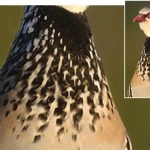feather
Figure 1 from Pérez-Rodríguez L et al., 2013.
A new study shows that the feather pattern on the chests of some birds (i.e. the bib) may be an outward sign of how healthy the bird is. The pattern the study refers to is called a fractal dimension, which is used to describe the complexity of the pattern (see image above). Researchers, Pérez-Rodríguez et al., discovered that red-legged partridges (Alectoris rufa) who were well-fed had more complex patterns than those who were food-restricted. Moreover, food-restricted animals weighed 13% less and had weaker immune systems.
Source:
Pérez-…
Dinosaur books have become more colourful affairs of late, with the dull greens, browns and greys of yesteryear replaced by vivid hues, stripes and patterns. This has largely been a question of artistic licence. While fossils may constrain an artist's hand in terms of size and shape, they haven't provided any information about colour. But that is starting to change.
The fossils of some small meat-eating dinosaurs were covered in filaments that are widely thought to be the precursors of feathers. And among these filaments, a team of Chinese and British scientists have found the distinctive…
The feather is an extraordinary biological invention and the key to the success of modern birds. It has to be light and flexible to give birds fine control over their airborne movements, but tough and strong enough to withstand the massive forces generated by high-speed flight. It achieves this through a complicated internal structure that we are only just beginning to fully understand, with the aid of unlikely research assistants - fungi.
At a microscopic level, feathers are made of a protein called beta-keratin. The same protein also forms the beaks and claws of birds, and the scales and…
